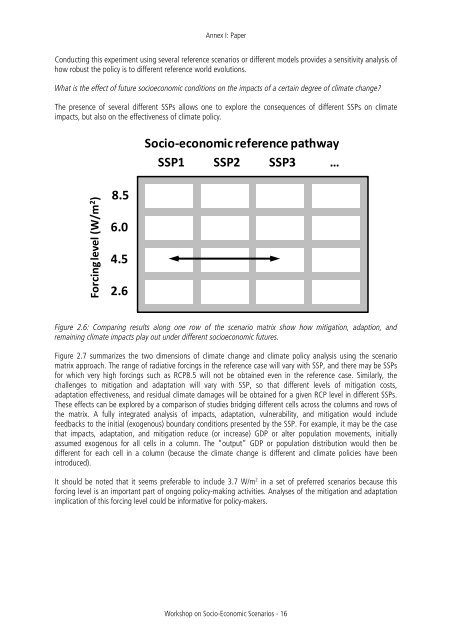Workshop Report - IPCC
Workshop Report - IPCC
Workshop Report - IPCC
Create successful ePaper yourself
Turn your PDF publications into a flip-book with our unique Google optimized e-Paper software.
Annex I: Paper<br />
Conducting this experiment using several reference scenarios or different models provides a sensitivity analysis of<br />
how robust the policy is to different reference world evolutions.<br />
What is the effect of future socioeconomic conditions on the impacts of a certain degree of climate change?<br />
The presence of several different SSPs allows one to explore the consequences of different SSPs on climate<br />
impacts, but also on the effectiveness of climate policy.<br />
Socio‐economic reference pathway<br />
SSP1 SSP2 SSP3 …<br />
Forcing level (W/m 2 )<br />
8.5<br />
6.0<br />
4.5<br />
2.6<br />
Figure 2.6: Comparing results along one row of the scenario matrix show how mitigation, adaption, and<br />
remaining climate impacts play out under different socioeconomic futures.<br />
Figure 2.7 summarizes the two dimensions of climate change and climate policy analysis using the scenario<br />
matrix approach. The range of radiative forcings in the reference case will vary with SSP, and there may be SSPs<br />
for which very high forcings such as RCP8.5 will not be obtained even in the reference case. Similarly, the<br />
challenges to mitigation and adaptation will vary with SSP, so that different levels of mitigation costs,<br />
adaptation effectiveness, and residual climate damages will be obtained for a given RCP level in different SSPs.<br />
These effects can be explored by a comparison of studies bridging different cells across the columns and rows of<br />
the matrix. A fully integrated analysis of impacts, adaptation, vulnerability, and mitigation would include<br />
feedbacks to the initial (exogenous) boundary conditions presented by the SSP. For example, it may be the case<br />
that impacts, adaptation, and mitigation reduce (or increase) GDP or alter population movements, initially<br />
assumed exogenous for all cells in a column. The “output” GDP or population distribution would then be<br />
different for each cell in a column (because the climate change is different and climate policies have been<br />
introduced).<br />
It should be noted that it seems preferable to include 3.7 W/m 2 in a set of preferred scenarios because this<br />
forcing level is an important part of ongoing policy-making activities. Analyses of the mitigation and adaptation<br />
implication of this forcing level could be informative for policy-makers.<br />
<strong>Workshop</strong> on Socio-Economic Scenarios - 16

















